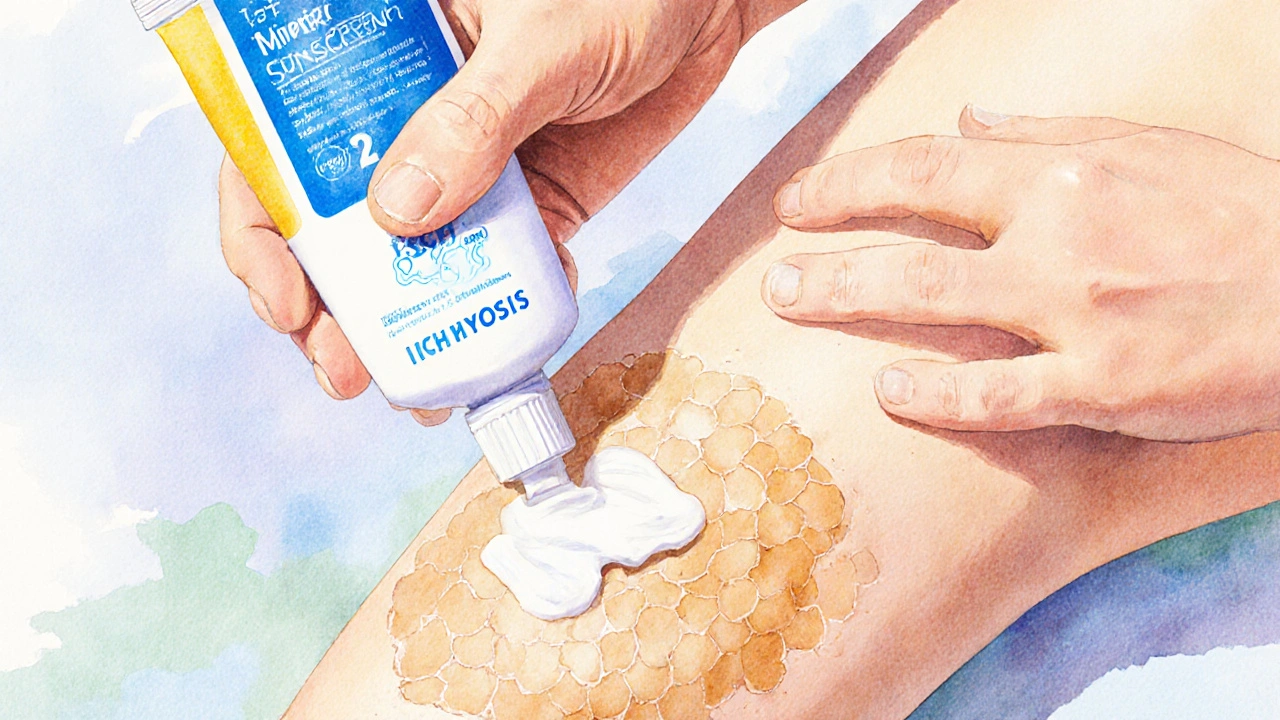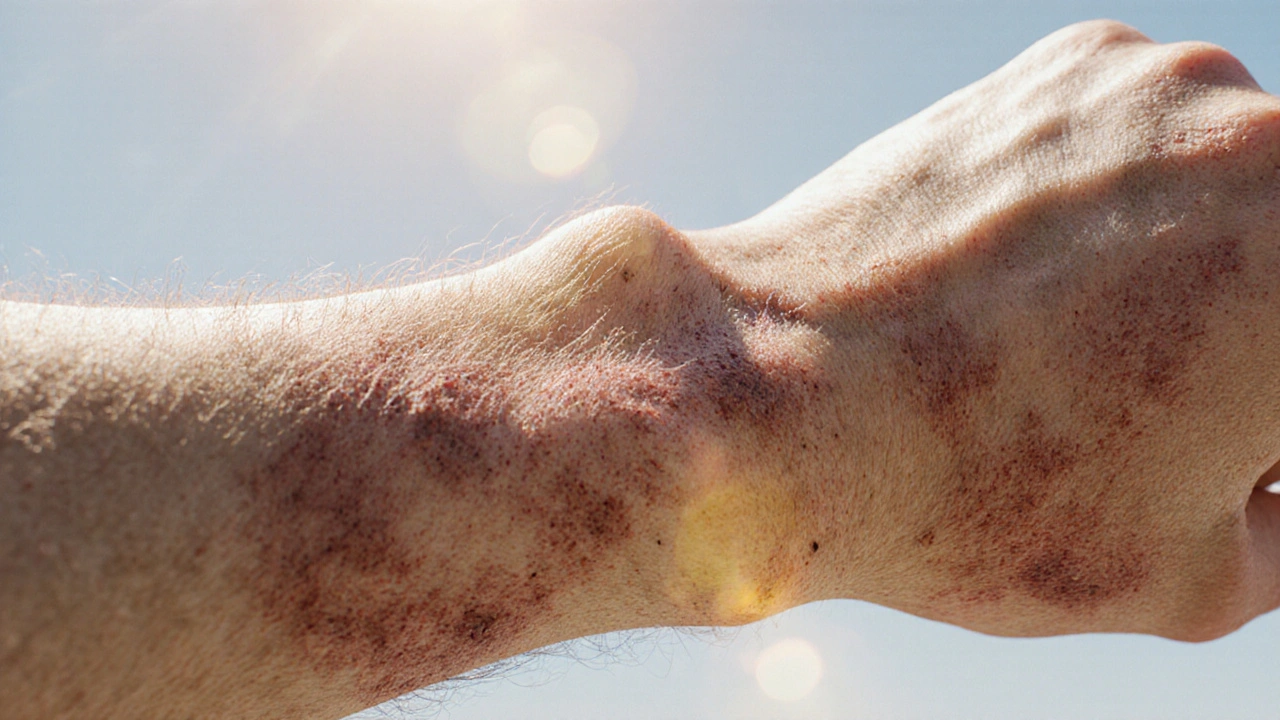Sun Protection Guide for Scaly Skin Conditions
Select Your Condition
Recommended Sun Protection
Select a condition above to see personalized sun protection recommendations.
Sunscreen Type Comparison
| Type | SPF Range | UVA Protection | Water-Resistant | Best For |
|---|---|---|---|---|
| Mineral (Zinc Oxide / Titanium Dioxide) | 30–50 | Broad-spectrum (UVA + UVB) | Yes (80 min) | Very sensitive or inflamed patches |
| Chemical (Avobenzone, Octocrylene, Homosalate) | 15–60 | Depends on formulation; high-UVA options exist | Varies | Normal to oily skin; when you need a lightweight feel |
| Hybrid (Mineral + Chemical blend) | 30–70 | Broad-spectrum | Often water-resistant | Mixed skin types; provides balance of texture and protection |
Daily Sun Safety Tips
- Apply 15–30 minutes before heading out. This gives the formula time to bind to the skin.
- Reapply every two hours or after swimming, sweating, or towel-drying.
- Wear protective clothing. Long-sleeve shirts made from tightly woven fabrics (UPF 50+ if possible) shield large areas.
- Seek shade during peak UV hours—roughly 10 am to 4 pm.
- Wear a wide-brim hat and UV-blocking sunglasses. The hat protects the scalp and hairline.
- Use lip balm with SPF 15+. The lips often get overlooked, but they’re prone to cracking in ichthyosis.
When you have skin that tends to develop Scaly Overgrowths of Skin is a group of conditions where the skin produces excessive keratin, leading to thick, rough patches such as psoriasis, ichthyosis, or seborrheic keratosis, the last thing you want is extra damage from the sun. Sun protection isn’t just about preventing a painful burn; it’s a key factor in controlling flare‑ups, reducing long‑term skin‑cancer risk, and keeping those patches as smooth as possible.
How UV Radiation Affects Scaly Skin
Ultraviolet light comes in two main flavors: UVA and UVB. While UVB is the chief culprit behind sunburn, UVA penetrates deeper, breaking down collagen and aggravating inflammation. For Ultraviolet Radiation is electromagnetic energy from the sun that reaches the Earth’s surface and can damage skin cells, both types can trigger a cascade of problems in already compromised skin.
- UVA accelerates oxidative stress, which makes scaly lesions redder and itchier.
- UVB can intensify the thickening of plaques in conditions like psoriasis.
- Repeated exposure weakens the skin’s barrier, allowing more moisture loss - a nightmare for people with ichthyosis.
Why Common Skin Conditions React Differently
Not every scaly disease is created equal. Understanding the nuances helps you pick the right protection strategy.
Psoriasis is an autoimmune disorder that speeds up skin cell turnover, causing raised, red, scaly patches. UV exposure can both help (through phototherapy) and hurt (by triggering Koebner phenomenon, where new lesions appear at sites of skin injury). For everyday life, the goal is to avoid accidental burns that could set off a flare.
Ichthyosis is a family of genetic disorders where the skin can’t shed properly, leading to thick, fish‑scale like patches. These patients already lose a lot of moisture; UV light worsens transepidermal water loss, making the skin feel tighter and crackier.
Seborrheic Keratosis is a benign, often waxy growth that can become darker and more raised with sun exposure. While not dangerous, they can look unsightly and may be mistaken for skin cancer.
Choosing the Right Sunscreen
The market is flooded with options, but for scaly skin you need a formula that won’t irritate, will stay on thick patches, and offers real UVA/UVB coverage.
| Type | Typical SPF Range | UVA Protection | Water‑Resistant | Best For |
|---|---|---|---|---|
| Mineral (Zinc Oxide / Titanium Dioxide) | 30‑50 | Broad‑spectrum (UVA+UVB) | Yes (80min) | Very sensitive or inflamed patches |
| Chemical (Avobenzone, Octocrylene, Homosalate) | 15‑60 | Depends on formulation; high‑UVA options exist | Varies | Normal to oily skin; when you need a lightweight feel |
| Hybrid (Mineral + Chemical blend) | 30‑70 | Broad‑spectrum | Often water‑resistant | Mixed skin types; provides balance of texture and protection |
When applying, use a generous amount-about a teaspoon for the face and a shot‑glass for the entire body. For thick plaques, massage the sunscreen in slowly; a mineral base is less likely to sting.

Practical Sun‑Protection Tips
- Apply 15‑30 minutes before heading out. This gives the formula time to bind to the skin.
- Reapply every two hours or after swimming, sweating, or towel‑drying.
- Wear protective clothing. Long‑sleeve shirts made from tightly woven fabrics (UPF 50+ if possible) shield large areas. For psoriasis elbows and knees, consider a lightweight, breathable cover.
- Seek shade during peak UV hours-roughly 10am to 4pm.
- Wear a wide‑brim hat and UV‑blocking sunglasses. The hat protects the scalp and hairline, where psoriasis plaques can be stubborn.
- Use lip balm with SPF15+. The lips often get overlooked, but they’re prone to cracking in ichthyosis.
Long‑Term Benefits of Consistent Sun Protection
Beyond immediate comfort, a disciplined sunscreen routine can change the disease trajectory.
- Reduced frequency of flare‑ups in psoriasis by up to 30% (observed in a 2022 cohort study).
- Lower risk of developing actinic keratoses or squamous cell carcinoma-both of which are more common in people with chronic scaly lesions.
- Improved skin hydration levels, especially in ichthyosis, where UV‑induced barrier damage can cause a 15% drop in moisture content.
- Better cosmetic outcome-lesions stay lighter and less crusty, making clothing choices easier.
When Sun Protection May Need Extra Care
Some treatments interact with UV light. If you’re undergoing Phototherapy is a medical treatment that uses controlled UV exposure to improve skin conditions like psoriasis, you’ll be given precise dosing schedules. In those cases, avoid additional sun exposure on treatment days to prevent over‑exposure.
Topical steroids or retinoids can make skin more photosensitive. Pair them with a high‑SPF mineral sunscreen and monitor for any burning sensations.

Common Myths Debunked
Myth 1: “If I have a tan, my skin is protected.” Tanning is actually a sign of DNA damage. It offers negligible protection compared to SPF 30+.
Myth 2: “I don’t need sunscreen on cloudy days.” Up to 80% of UV rays pass through clouds, so you still need protection.
Myth 3: “All sunscreens are the same for scaly skin.” Formulations vary in irritancy. Mineral sunscreens are generally gentler on inflamed patches.
Quick Checklist for Daily Sun Safety
- Choose a broad‑spectrum sunscreen with SPF30or higher.
- Apply liberally to all exposed skin, focusing on plaques.
- Reapply at least every two hours.
- Wear UPF‑rated clothing, a hat, and sunglasses.
- Avoid peak UV hours when possible.
- Check medication labels for photosensitivity warnings.
Frequently Asked Questions
Can sunscreen worsen my psoriasis plaques?
Most modern sunscreens are formulated to be non‑irritating. Mineral sunscreens (zinc oxide or titanium dioxide) are the safest choice for inflamed plaques. If you notice stinging, switch to a fragrance‑free, broad‑spectrum mineral product and apply a thin layer of moisturizer underneath.
Is a higher SPF always better for scaly skin?
SPF30 blocks about 97% of UVB rays, while SPF50 blocks roughly 98%. The difference is modest, but higher SPF often means a thicker layer, which can feel greasy on thick patches. Choose the highest SPF you can comfortably apply, and reapply often.
Do I need sunscreen on cloudy winter days?
Yes. UV radiation penetrates clouds, and snow can reflect up to 80% of UV rays, increasing exposure. A lightweight mineral sunscreen works well under winter jackets.
How does sunscreen interact with topical steroids?
Steroids thin the skin, making it more photosensitive. Apply the steroid first, let it absorb (about 5minutes), then layer sunscreen on top. This order protects the skin without diluting medication efficacy.
Are there any natural alternatives to commercial sunscreen?
Some plant oils (e.g., raspberry seed oil) offer modest SPF10‑15, but they’re not reliable for medical skin conditions. For scaly overgrowths, stick with FDA‑approved broad‑spectrum products.
Keeping your scaly skin safe under the sun isn’t a one‑size‑fits‑all chore-it’s a daily habit that pays off in fewer flares, better comfort, and lower cancer risk. Pick a gentle, broad‑spectrum sunscreen, layer it correctly, and combine it with smart clothing choices. Soon you’ll notice your skin staying calmer, smoother, and less prone to the dreaded sun‑induced surprises.

